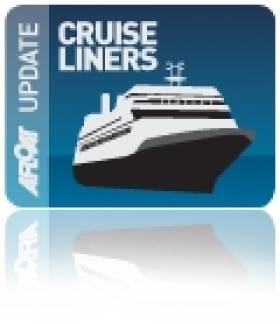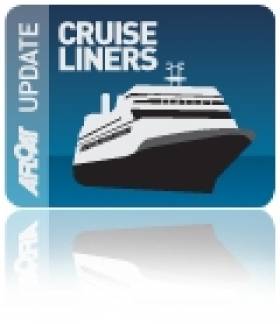Displaying items by tag: Princess Daphne
#CRUISESHIP DETENTION – The High Court has ordered the arrest and detention of Princess Danae (1955/16,531grt) which arrived into Dublin Port today.
The cruiseship as previously reported on Afloat.ie, has a capacity to carry more than 800 passengers and crew, was detained arising out of an alleged failure by its owners to pay an outstanding fuel bill of US$94,000 (€75,000).
The former general cargoship, which is registered in Madeira, docked into the port's Alexandra Basin this morning and was due to depart at 7pm this evening.
A Classic Double Act: From General Cargoships to Cruise Liners
#CARGO TO CRUISELINERS – This morning saw the arrival of World Cruises Agency,'s Princess Daphne to Dublin Port, the veteran vessel built in 1955 was originally launched as a cargoship, writes Jehan Ashmore.
The 18,833grt cruiseship had arrived into Dublin Bay from Falmouth, however her cruise embarkation port was from Portsmouth, where World Cruises started their inaugural cruise call to Ireland. Yet again another newcomer operating in Irish waters this season.
In recent years Princess Daphne and her sister Princess Danae, have operated for Classic Cruises International (CIC), and they were among a fleet of older tonnage.
Before she became Princess Daphne, she was commissioned for Port Line (subsidiary of Cunard Line) and was built at the shipyard of Swan Hunter on Newcastle-upon-Tyne and launched as Port Sydney. She was joined by her sister Port Melbourne, also completed in the same year but built by Harland & Wolff. They were ordered to serve the UK route to New Zealand, Australia via the Panama Canal.
The handsome looking general cargoships or 'reefers' (handling meat exports) had a large superstructure, with accommodation for 12 passengers. Noting the wraparound passenger veranda deck and six cargo-holds accompanied by derricks for self-unloading.
Conversion work took place in 1975 and again this applied to her sister the following year. The rebuild included replacing the old superstructure with a large longer streamlined superstructure, noting fore-ward of the bridge are the derricks that was incorporated during the work. This feature does not apply to Princess Danae which has an extended structure instead.
They retain their have deep-drafted (7.9m) hulls, complete with many portholes along sheer classic lines. Princess Daphne has a hull length of 162.39m which is marginally longer then her sister's 162.31m.
Over their respective career spanning nearly six decades, they have operated for several owners and under different names, however their current names have remained for some time. The pair are both Portuguese flagged and operated by World Cruises based in Lisbon.
Incidentally Princess Danae (1955/16,531grt) will be making a call to Dublin Port tomorrow, as she is scheduled to arrive at her birthplace in Belfast Harbour today. Also in port, is Plantours & Partners Cruises Hamburg, which had sailed overnight from Dublin Port, as previously reported on Afloat.ie.
Graceful Lady Liner to Visit Dublin
The vessel was launched as Port Sydney in 1955 from Swan Hunter and Wigham Richardson Yards, Wallsend-on-Tyne for Port Line, a subsidiary of Cunard Line. With five cargo holds, the vessel served both the meat trade and carried passengers on liner-route services between the UK and New Zealand and Australia via the Panama Canal.
In 1974, Port Sydney underwent a radical conversion into a luxury passenger cruise ship, despite the exterior appearance the vessel retains a pleasant profile compared to many modern cruiseships. Over the decades the vessel had different owners and several vessel name changes; Daphne, Switzerland and Ocean Monarch.
The most refit was in 2008 and the ship still retains the largest cabins found on any cruise ship today, of the 241 cabins. With spacious cabins for only 550 passengers and attractive appointed public areas and wide exterior decks, the veteran provides a form of cruising that would appeal to classic cruise aficionados around the world.
With a strong and sturdy hull, the vessel has a deep draft which is well suited to an ocean going vessel in handling inclement weather, though the large draft does restrict visiting certain ports and anchorage locations.
Sistership, Princess Danae, formerly Port Melbourne, was also built in 1955 with the second newbuild ordered to the famous Belfast shipbuilders, Harland & Wolff. Princess Danae is slightly smaller at 15,833grt and also made a recent call in Dublin. The sisters form part of a six vessel fleet operated by Classic International Cruises.
Princess Daphne is due to arrive in Dublin after an overnight passage from Plymouth, docking at 08.00 and depart the capital at 17.45hrs. In addition the port expects another cruise-call tomorrow in the form of Prinsendam of 37,983 grt and with over a 800-passenger capacity. The Dutch flagged vessel is operated by Holland America Line and is due to dock around mid-moring and depart at 23.30hrs.

























